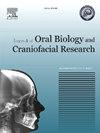An umbrella review of systematic reviews/meta-analyses evaluating the antimicrobial activity of various nanoparticles on orthodontic materials & components
Q1 Medicine
Journal of oral biology and craniofacial research
Pub Date : 2025-06-09
DOI:10.1016/j.jobcr.2025.06.002
引用次数: 0
Abstract
Introduction
White spot lesions (WSLs) are a prevalent issue during fixed orthodontic treatment. Orthodontic materials, such as wires, brackets, and adhesives, often create an environment that promotes microbial growth, particularly from acidogenic bacteria like Streptococcus mutans, leading to enamel demineralization. Traditional preventive measures include fluoride treatments and meticulous oral hygiene, but integrating antimicrobial nanoparticles into orthodontic materials offers a promising alternative. This umbrella review evaluates the antimicrobial efficacy of nanoparticles incorporated into orthodontic materials by assessing evidence from systematic reviews and meta-analyses. Various nanoparticles, including ZnO, Ag, and TiO2, were studied for their potential to reduce microbial colony formation and adherence to orthodontic materials.
Materials and method
A literature search was conducted across PubMed, Google Scholar, The Cochrane Library, and LILACS, yielding one hundred and sixty-seven articles after removing duplicates. Following abstract and title screening, twenty-seven studies were selected for full-text review, and nine were included in the qualitative analysis. This review adheres to PRISMA guidelines and is registered with PROSPERO (CXXXXXXXXXXXX2).
Results
The studies indicate that incorporating AgNP into orthodontic adhesives enhances antimicrobial activity but exhibits high heterogeneity, necessitating more in vivo studies. TiO2-coated brackets show antimicrobial properties against various pathogens. Nanoparticle-coated archwires with AgNP, N-doped TiO2, graphene oxide, and zinc oxide reduce demineralization, are biocompatible, and reduce surface roughness, showing good to fair antimicrobial activity. Results should be interpreted cautiously, and further clinical and long-term studies are required to confirm the effectiveness of these nanoparticles in preventing white spot lesions.
系统综述/荟萃分析评估各种纳米颗粒对正畸材料和组件的抗菌活性
白斑病变(WSLs)是固定正畸治疗中普遍存在的问题。正畸材料,如金属丝、托槽和粘合剂,通常会创造一个促进微生物生长的环境,尤其是产酸细菌,如变形链球菌,导致牙釉质脱矿。传统的预防措施包括氟化物治疗和细致的口腔卫生,但是将抗菌纳米颗粒整合到正畸材料中提供了一个有希望的替代方案。本综述通过评估来自系统综述和荟萃分析的证据来评估纳入正畸材料的纳米颗粒的抗菌功效。研究了各种纳米颗粒(包括ZnO、Ag和TiO2)减少微生物菌落形成和粘附在正畸材料上的潜力。资料与方法在PubMed、谷歌Scholar、The Cochrane Library和LILACS进行文献检索,剔除重复文献后得到167篇。经过摘要和标题筛选,选取27篇研究进行全文综述,其中9篇纳入定性分析。本综述遵循PRISMA指南,并在普洛斯彼罗注册(CXXXXXXXXXXXX2)。结果研究表明,将AgNP掺入正畸粘接剂中可以增强抗菌活性,但具有较高的异质性,需要更多的体内研究。二氧化钛涂层支架显示对各种病原体的抗菌性能。纳米粒子包被AgNP、n掺杂TiO2、氧化石墨烯和氧化锌的弓丝可以减少脱矿,具有生物相容性,降低表面粗糙度,具有良好的抗菌活性。结果应谨慎解读,需要进一步的临床和长期研究来证实这些纳米颗粒在预防白斑病变方面的有效性。
本文章由计算机程序翻译,如有差异,请以英文原文为准。
求助全文
约1分钟内获得全文
求助全文
来源期刊

Journal of oral biology and craniofacial research
Medicine-Otorhinolaryngology
CiteScore
4.90
自引率
0.00%
发文量
133
审稿时长
167 days
期刊介绍:
Journal of Oral Biology and Craniofacial Research (JOBCR)is the official journal of the Craniofacial Research Foundation (CRF). The journal aims to provide a common platform for both clinical and translational research and to promote interdisciplinary sciences in craniofacial region. JOBCR publishes content that includes diseases, injuries and defects in the head, neck, face, jaws and the hard and soft tissues of the mouth and jaws and face region; diagnosis and medical management of diseases specific to the orofacial tissues and of oral manifestations of systemic diseases; studies on identifying populations at risk of oral disease or in need of specific care, and comparing regional, environmental, social, and access similarities and differences in dental care between populations; diseases of the mouth and related structures like salivary glands, temporomandibular joints, facial muscles and perioral skin; biomedical engineering, tissue engineering and stem cells. The journal publishes reviews, commentaries, peer-reviewed original research articles, short communication, and case reports.
 求助内容:
求助内容: 应助结果提醒方式:
应助结果提醒方式:


